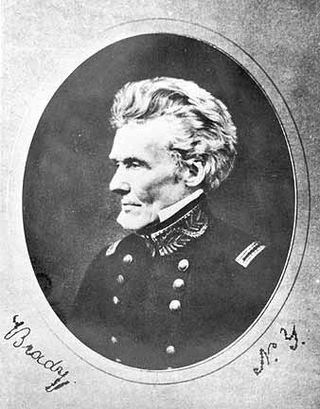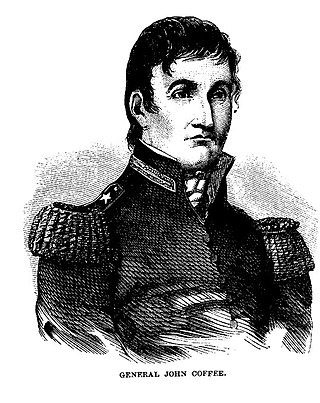
The War of 1812 was fought by the United States and its allies against the United Kingdom and its allies in North America. It began when the United States declared war on Britain on 18 June 1812. Although peace terms were agreed upon in the December 1814 Treaty of Ghent, the war did not officially end until the peace treaty was ratified by the United States Congress on 17 February 1815.

The Battle of Horseshoe Bend, was fought during the War of 1812 in the Mississippi Territory, now central Alabama. On March 27, 1814, United States forces and Indian allies under Major General Andrew Jackson defeated the Red Sticks, a part of the Creek Indian tribe who opposed American expansion, effectively ending the Creek War.

The Creek War was a regional conflict between opposing Native American factions, European powers, and the United States during the early 19th century. The Creek War began as a conflict within the tribes of the Muscogee, but the United States quickly became involved. British traders and Spanish colonial officials in Florida supplied the Red Sticks with weapons and equipment due to their shared interest in preventing the expansion of the United States into regions under their control.

Edmund Pendleton Gaines was a career United States Army officer who served for nearly fifty years, and attained the rank of major general by brevet. He was one of the Army's senior commanders during its formative years in the early to mid-1800s, and was a veteran of the War of 1812, Seminole Wars, Black Hawk War, and Mexican–American War.

John R. Coffee was an American planter of English descent, and a state militia brigadier general in Tennessee. He commanded troops under General Andrew Jackson during the Creek Wars (1813–14) and during the Battle of New Orleans in the War of 1812.

The Fort Mims massacre took place on August 30, 1813, at a fortified homestead site 35-40 miles north of Mobile, Alabama, during the Creek War. A large force of Creek Indians belonging to the Red Sticks faction, under the command of headmen Peter McQueen and William Weatherford, stormed the fort and defeated the militia garrison.

The Capture of Fort Niagara took place 18-19 December 1813 during the War of 1812 between Great Britain and the United States. The American garrison was taken by surprise, and the fort was captured in a night assault by a select force of British regular infantry.
Timeline of the War of 1812 is a chronology of the War of 1812, including a list of battles.

Samuel Dale, known as the "Daniel Boone of Alabama", was an American frontiersman, soldier, and politician, who fought under General Andrew Jackson, in the Creek War, later, becoming a brigadier general in the U.S. Army, and an advocate for Alabama statehood.

Colonel Caleb Hopkins was an officer during the War of 1812 and the first town supervisor of Pittsford, New York, United States.

The Battle of Holy Ground, or Battle of Econochaca, was fought on December 23, 1813, between the United States militia and the Red Stick Creek Indians during the Creek War. The battle took place at Econochaca, the site of a fortified encampment established in the summer of 1813 by Josiah Francis on a bluff above the Alabama River, in what is now Lowndes County, Alabama. It was one of three encampments erected by Red Stick Creeks that summer. In addition to the physical defenses, Creek prophets performed ceremonies at the site to create a spiritual barrier of protection. Hence the Creek name "Econochaca," loosely translated as holy ground, but properly translated as sacred or beloved ground.

The Battle of Buffalo took place during the War of 1812 on December 30, 1813, in the State of New York, near the Niagara River. The British forces drove off the American defenders and destroyed many buildings and ships. The operation was retaliation for American troops burning the Canadian village of Newark.
The Canadian Volunteers was a unit composed of pro-United States citizens or inhabitants of Upper Canada which fought for the United States of America during the Anglo-American War of 1812.

Fort Claiborne was a stockade fort built in 1813 in present-day Monroe County, Alabama during the Creek War.

Fort Armstrong was a stockade fort built in present-day Cherokee County, Alabama during the Creek War. The fort was built to protect the surrounding area from attacks by Red Stick warriors but was also used as a staging area and supply depot in preparation for further military action against the Red Sticks.

Fort Hull was an earthen fort built in present-day Macon County, Alabama in 1814 during the Creek War. After the start of hostilities, the United States decided to mount an attack on Creek territory from three directions. The column advancing west from Georgia built Fort Mitchell and then clashed with the Creeks. After a pause in operations, the column from Georgia continued its march and built Fort Hull. The fort was used as a supply point and was soon abandoned after the end of the Creek War.

Thomas Flournoy (1775-1857) was a lawyer from Georgia and an officer in the Georgia Militia who was commissioned brigadier general in the United States Army when the War of 1812 began. In 1813 he became commanding officer of the Seventh Military District with headquarters in New Orleans. There he alienated important political leaders by questioning their loyalty. During the operations against the Red Sticks in Alabama he only half-heartedly supported the troops in the field, as the operations took place in his district but was under the overall command of Thomas Pinckney. Having been relieved of his command Flournoy resigned in 1814. In 1820 he was one of the United States commissioners negotiating with the Creeks, but he resigned the same year as a consequence of what he saw as undue interference from the State of Georgia.

Fort Madison was a stockade fort built in August 1813 in present-day Clarke County, Alabama, during the Creek War, which was part of the larger War of 1812. The fort was built by the United States military in response to attacks by Creek warriors on encroaching American settlers. The fort shared many similarities to surrounding stockade forts in its construction but possessed a number of differences in its defenses. The fort housed members of the United States Army and settlers from the surrounding area, and it was used as a staging area for raids on Creek forces and supply point on further military expeditions. Fort Madison was subsequently abandoned at the conclusion of the Creek War and only a historical marker exists at the site today.
Fort Montgomery was a stockade fort built in August 1814 in present-day Baldwin County, Alabama, during the Creek War, which was part of the larger War of 1812. The fort was built by the United States military in response to attacks by Creek warriors on encroaching American settlers and in preparation for further military action in the War of 1812. Fort Montgomery continued to be used for military purposes but in less than a decade was abandoned. Nothing exists at the site today.
Fort Pierce, was two separate stockade forts built in 1813 in present-day Baldwin County, Alabama, during the Creek War, which was part of the larger War of 1812. The fort was originally built by settlers in the Mississippi Territory to protect themselves from attacks by Creek warriors. A new fort of the same name was then built by the United States military in preparation for further action in the War of 1812, but the fort was essentially abandoned within a few years. Nothing exists at the site today.















